In a combat situation, if skill levels are equally matched, the stronge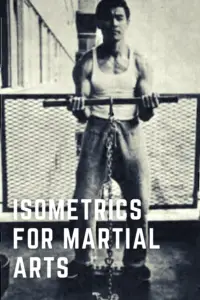 r and faster fighter will usually come off better. Technique should always be the primary focus of any martial artist’s training, but it should never be at the expense of developing strength and endurance. Many fighters make the mistake of going to the gym and training using a bodybuilding routine, involving lots of reps and sets. This will develop muscle and strength but this extra tissue is hugely energy and oxygen hungry. You only have to look at UFC fights involving hugely muscular fighters against those with seemingly average physiques; the ripped fighters frequently gas out very quickly as their muscles tire. Fortunately, there is a way of getting ridiculously strong without excessively bulking up – isometrics.
r and faster fighter will usually come off better. Technique should always be the primary focus of any martial artist’s training, but it should never be at the expense of developing strength and endurance. Many fighters make the mistake of going to the gym and training using a bodybuilding routine, involving lots of reps and sets. This will develop muscle and strength but this extra tissue is hugely energy and oxygen hungry. You only have to look at UFC fights involving hugely muscular fighters against those with seemingly average physiques; the ripped fighters frequently gas out very quickly as their muscles tire. Fortunately, there is a way of getting ridiculously strong without excessively bulking up – isometrics.
Isometrics vary from normal weight training. When training with dumbbells, barbells or machines, you typically raise and lower the weight for a certain number of reps, before taking a short rest before you repeat the exercise for your next set.
A typical weight training session will last about an hour and is performed three times a week. If you’re looking to get better at a martial art, then this time would be better spent training in your martial art. Isometrics can be performed very quickly (each exercise lasts about 10 seconds) allowing you to get extremely strong whilst allowing you to focus on your martial art.
In isometrics, there is no movement involved. There are two types of isometrics:
Overcoming isometrics involves trying to move an immovable object, for instance trying to deadlift a heavy barbell that you cannot normally move even for one rep.
Yielding isometrics involves trying to hold a heavy weight in the same position for as long as possible. For instance, a weighted barbell in a fixed bicep curl position for as long as possible. As the muscles tire, the bar will inevitably be lowered to the ground.
It’s the overcoming isometric exercises that we’ll focus on in this article and how they can be incorporated into the martial arts.
How do isometric exercises work?
During an isometric exercise, the muscle contracts without shortening. Imagine trying to deadlift a barbell loaded with a weight that was so heavy you couldn’t even hope to lift it. Using proper form, you would crouch down and grab the bar. You would then try to lift the weight using maximum effort to the extent that your muscles might tremble at the effort. The hold would be held for 7-10 seconds.
Whilst the barbell won’t actually move, your muscles would get an extremely intense workout.
The human body is a very efficient organism and takes various steps not to waste energy. In regular weight training, only the muscle fibers needed to move the weight will actually fire. For instance, to move a light weight, only a limited number of fibers will fire. As the weight is increased, more and more of the muscle will need to fire in order to move the weight.
Trying to lift an immovable object, which is essentially the maximum weight possible, will cause all the fibers in the muscle to fire in an attempt to move the weight.
So whilst you may only be performing the exercise for 7-10 seconds, the work performed by the muscle is so intense it is more than enough to trigger an adaptive response by the body.
The way in which isometrics increases an individual’s strength is by improving the fibres within the muscles ability to fire all together at the same time. So whilst there won’t be a huge increase in muscle size (although there will be some), it becomes much more efficient in contracting.
When someone has been training using isometrics for some time, they are able to ‘switch on’ all the fibers in their muscle. An untrained individual’s muscle won’t be this efficient and a smaller proportion of muscle fibers will fire. It’s isometrics ability to develop the muscle’s efficiency in firing that makes it such a potent tool for strength development.
This form of training became all the rage in the 1960s. It was largely popularized by Bob Hoffman and his York Barbell company. He designed an isometric power rack; similar in some ways to a modern power rack but with a much narrower distance between the uprights. Between the uprights were two sets of strong safety pins. However, instead of these pins being used as a safety net when squatting or bench pressing, the idea was to press with maximal force against these pins with a barbell for 6-7 seconds at various positions within each of the Olympic lifts. The pins could be adjusted at various heights to exercise the muscles at different points. Hoffman’s methodology is detailed in his book.
This resulted in dramatic increases in strength in the athletes that practiced these techniques.
However, isometrics has a much older history that this.
Isomterics for Wrestling
Isometrics has been used as a training tool in wrestling for many years.
Ghulam Muhammad (Gama) was born in May 1878 in Amritsar, Punjab, and from the age of 10, started practising wrestling. He became so proficient that in 1910, he travelled to London and beat many of the wrestling stars at the time. The main thing that separated him from his opponents was his amazing strength. He developed this strength by tying a belt round a tree and trying to throw the tree. Of course, the tree was an immovable object but having his muscles repeatedly strain at the attempt caused them to develop.

More recently, between 1940 and 1952, American Henry Witternberg became the National A.A.U. champion no less than eight times.
He wrestled in the 191 lb and heavy weight divisions and remained undefeated after 400 consecutive matches. He won Gold at the 1948 Olympics in London and in 1977, he was inducted into the National Wrestling Hall of Fame. Henry practiced holds on a football dummy, exerting pressure without motion and developing his strength in this way. He attributes this type of training to his success. He went on to write a book on isometric training.
Isometrics for Kung Fu
Perhaps the best known proponent of Kung Fu of all time is Bruce Lee who managed to sculpt an athletic physique that was not only light and agile but also incredibly explosive. Looking at his training methodology, it’s evident that Bruce incorporated isometrics as one of his training tools.

In this picture, Bruce is performing an isometric bicep curl. Note that he is standing on a platform to which is attached a metal chain attached to the pole. The chain means that the bar remains in a fixed position; the idea is that by straining to pull the bar upwards in a curl, the biceps muscles receive an extremely intense workout and become stronger as a result. The chains length can be adjusted, enabling a wide variety of exercises to be performed including shoulder presses, Jefferson squats, calf raises to name but a few. Modern versions of this device are still on sale, and example of which can be seen here (link to Amazon).
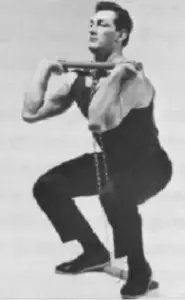
In this photo, Bruce is training in a isometric power rack performing one of the exercises recommended by Bob Hoffman, most likely a calf raise as featured in his book.
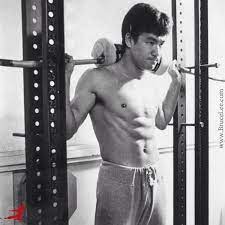
In this photo, Bruce Lee is chatting on the phone but in the background a Bullworker can be clearly seen leaning against the wall, strongly suggesting that he incorporated this device into his training.

The Bullworker is a classic isometric training tool. It was developed in the 1960s by Gert F. Kölbel and consists of two cylinder containing a strong spring. Handles at each end can be squeezed together, compressing the spring. In addition, two straps are attached to each of the handles and if they are pulled apart then, again the spring is compressed. This enables a huge number of exercises to be performed. The more modern version can be seen here (link to Amazon).
It’s clear the Bruce Lee incorporated isometrics into his training program and helps to explain his phenomenal strength to weight ratio.
Isometrics for Karate
Isometrics also feature in karate, particularly in the more traditional styles, such as Shotokan.
This style features a lot of long deep stances that, during training, are held for a considerable amount of time.
During my own karate training, I remember frequently having to hold a static horse stance for extended durations whilst performing punching and blocking motions. After only a short period of time my legs would begin to quiver. This was a form of yielding isometric and was designed to strengthen the leg muscles. Stronger leg muscles would lead to more powerful kicks.
It’s certainly no accident that many traditional martial arts feature long, deep stances. This type of yielding isometric certainly does build exceptional lower body strength and power.
Isometrics for Brazilian Jiu Jitsu (BJJ)
Isometrics are fantastic for BJJ. In this sport you’re frequently training against an unwilling opponent who is reluctant to be moved. In many ways, it’s a form of overcoming isometric in that your opponent is an immovable object.
Now obviously technique plays a central part of BJJ but if you have two equally skilled and sized opponents, then the stronger fighter will win.
One of the common positions in BJJ is when you’re on your back on the floor with your opponent on top of you in perhaps side mount. As you’re defending, a common position you’ll find yourself in is with your hands together in a prayer type position. From this position, you can try to push your opponent upwards in order to try and make space. The space between you and your opponent allows you to turn your body and move your arms to a more advantageous position.
It would be difficult to train this defensive prayer position using conventional weight training. Perhaps the closest to it would be the close grip bench press but the range of movement would be considerably reduced. A more effective technique would be to train isometrically.
To do this you can use your gi belt. Tie the belt to create a loop that can fit around your back and chest. Now slip your hands under the belt in the prayer position. You need to tie the knot so that when you push against the belt, it mimics the same position when you’re actually grappling.
Once you have the loop in position and your hands in place, push against the loop. You’ll barely be able to move your hands forward as the belt restricts your movement – that’s the idea; it’s an overcoming isometric movement.
Once the slack in the belt has been taken out, you then want to push against the belt with maximal effort. Your arms should tremble at the effort. Breath out throughout the exercise. You should maintain this effort for 7-10 seconds.
This is a tremendous exercise for your tricep and chest and develops maximal strength in the “prayer position”.
Isometrics can also be used to increase your strength when performing chokes. When I practised bjj, I used this technique a lot when trying to perfect the rear naked choke. It involves using a muscle roller which is about the thickness of a person’s neck.
Using the roller, get into the position of the choke you’re trying to perform. Now here’s the trick: once in position, squeeze the roller as hard as you can as though you are performing the choke for real. Maintain this maximal effort for 7-10 seconds.
If you practise this technique regularly, you will develop a vice like choke hold that will force your opponent to tap out as quickly as they can.
Below is a video with John Connors demonstrating how to incorporate isometrics into your trainnig.
Isometrics for Boxing
In boxing, one of the most desirable attributes is to have a strong powerful punch. Hard hitters are capable of stopping a fight instantaneously. Isometrics are able to assist fighters in becoming heavy hitters.
To practise this technique, wear boxing gloves and stand in a boxing stance facing a solid wall. Now throw a punch in slow motion towards the wall stopping when the fist would have hit your imaginary opponent.
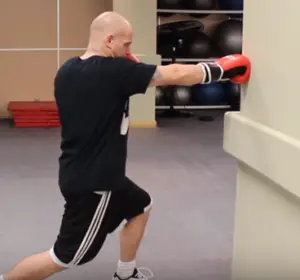
Holding this position, shuffle towards the wall until your fist is pushed up against wall. Once in position, press your fist into wall, gradually increasing the pressure until you’re pushing as hard as possible.
The power of a punch actually comes from the ground upwards as you push from the floor. This is known as the kinetic chain. As a result, when practising this technique, you should feel the muscles in your forearm, triceps, shoulders, chest, legs and calves begin the contract. They may even tremble at the effort.
Isometrics used in this way will develop all the various muscles involved when you punch.
Summary
Isometrics are an extremely useful way of getting seriously strong without getting unnecessary size gains. Whilst large muscles might be good for show, they are serious energy and oxygen drainers which will cause you to gas out after only a short time. If you’re serious about your martial arts training, then you need to seriously consider isometrics to complement your training.
FAQ
Can you do isometrics everyday?
Isometrics only take a short time to perform and provide a very intene work out. Performing this type of workout does not overburden the Central Nervous System. Henry Witternberg, the famous American wrestler, recommended that they be performed everyday.
Are isometrics better than weights?
It really depends on what is meant by better. In terms of time efficiency, you really can’t beat isometrics. In just a few minutes, your can complete an isometric exercise routine and be well on your way to developing significant functional strength.
Be under noillusion that this type of strength training is effective. The famous Russian strongman, Alexander Zass (1888 – 1962), trained almost exclusively in this manner using a various lengths of chain with handles at each end. A bit like the modern day Iso-Bow (link to Amazon).
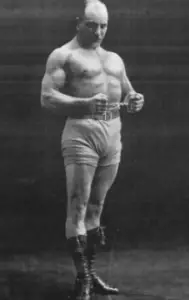
Are isometrics good for joints?
One of the advantages of isometric exercises is that there is no movement involved. There is therefore minimal wear on your joints. If you do have any joint issues, then it would be worthwhile incorporating isometrics into your training.
Do isometrics strengthen tendons?
Isometrics involve you muscles contracting at their maximum possible capacity as more and more muscle fibres are recruited to try and move an immovable object. These fibers pull on the tendons that connect the muscle to the bones. With continued isometric training these tendons become stronger in order to withstand the stresses they are subjected to.
Do isometrics cause hypertrophy?
The short, intense isometrics describe so far, lasting 7-10 seconds, are designed to quickly develop strength. You will develop some muscle mass (just look at Alexander Zass’s physique) but if your aim is to use isometrics to develop muscle mass, then you’ll need to hold the isometric hold for a longer period: 45-50 seconds. You won’t be able to perform the longer contraction at the same level of intensity but you should aim to contract the muscles as hard as you can for the duration of the exercise; you’re muscles should be trembling with the effort.
How often should isometrics be done?
The American wrestler, Henry Witternberg, recommended that isometric exercises could be performed everyday. They don’t take much time at all to complete; you could complete an entire isometric routine in under ten minutes.
How many sets of isometrics?
Henry Witternberg, the highly successful American wrestler, recommends just one set of each isometric exercise is performed. This type of exercise is very intense so it’s arguable that if you feel you need to perform a second set then you weren’t putting enough effort into your original set. Focus on quality of contraction not quantity of sets.
Why did Bruce Lee do isometrics?
Bruce Lee was constantly looking at methods he could incorporate into his training in order to become a better martial arts practitioner. He was no doubt aware of their ability to dramatically increase functional strength and power in a very time efficient manner.
Related Posts
Original, Vintage Bullworker X5 Review and Exercises
The Bullworker Iso-Bow Review
Isometrics build muscle fast!!
Isometrics for martial arts: how you can get really strong
Is the Bullworker as good as weights?
Bullworker vs Isokinator vs Isobow
The best isometric exercise equipment 2022(with pictures)
Will a Bullworker build muscle?
The Benefits of Isometric Exercise
How to Incorporate Isometrics into Your Workout
Isometric Exercise vs. Dynamic Exercise: Which is Better?
Isometric Exercises for Building Strength and Endurance
